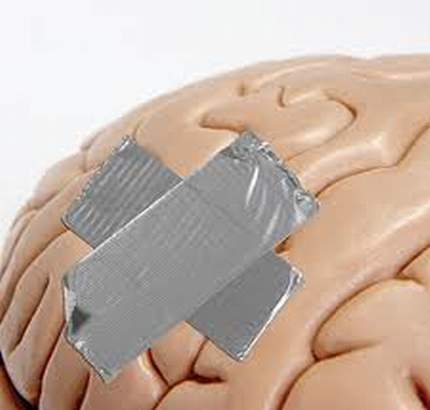What's in this article?
Chronic traumatic encephalopathy Overview
Chronic traumatic encephalopathy (CTE) results from blows to the head over a period of time that cause concussion (mild traumatic brain injury). These injuries lead to difficulties with thinking (cognition), emotions and behaviors that do not become noticeable until many years later. CTE can lead to physical problems as well. Not everyone who has one or more concussions develops CTE.
CTE involves progressive damage to nerve cells (neurodegenerative disease). The damage results in visible changes to the brain. Some of these changes can be seen with brain imaging, but a diagnosis at this time can be made only on inspection after death (autopsy). Researchers are working to find a way to diagnose CTE in those who have the disease while the individuals are still alive.
Originally called punch drunk syndrome (dementia pugilistica), CTE was first demonstrated in boxers. Doctors now know that other individuals who play a wide variety of sports that involve repeated blows to the head, such as football players, can develop CTE. Military personnel who have had blast injuries also are at risk.
Researchers do not yet fully understand CTE’s prevalence and causes. There is no cure for CTE.
Symptoms of Chronic Traumatic Encephalopathy
The symptoms of CTE can be debilitating and may have life-changing effects for both the individual and for his or her family. Some of the most common include loss of memory, difficulty controlling impulsive or erratic behavior, impaired judgment, behavioral disturbances including aggression and depression, difficult with balance, and a gradual onset of dementia. An individual with CTE may mistakenly ascribe the symptoms to the normal process of aging, or might receive a wrong diagnosis due to the fact that many of the symptoms are similar to other conditions such as Alzheimer’s or Parkinson’s disease. CTE has been diagnosed in several notable cases which received widespread media attention, including the suicide deaths of NFL player Junior Seau, and professional wrestler Chris Benoit who committed suicide after murdering his wife and son.
Causes of Chronic Traumatic Encephalopathy
Initial injury
The main cause of CTE is repetitive head trauma. Football players have been the focus of most CTE studies. However, athletes participating in other sports, including soccer, ice hockey, rugby, boxing, wrestling, basketball, field hockey, cheerleading, volleyball and lacrosse, may experience repeated head impacts and also have high rates of concussion.
Blast injuries to military personnel also can result in CTE.
However, not all athletes and not everyone who experiences repeated concussions, including military personnel, go on to develop CTE.
Effect of injury
CTE causes the wasting away (atrophy) of many parts of the brain. Injuries to the section of nerve cells involved in conducting electrical impulses (axons) interfere with cell-to-cell communication. Other changes include deposits of the proteins tau and TDP-43, and changes in white matter the part of the brain made up of nerve fibers. Unlike in Alzheimer’s disease, deposits of beta-amyloid, another protein, are not common.
More than one-third of people with CTE also have signs of another neurodegenerative disease, including Alzheimer’s disease, motor neuron disease, Parkinson’s disease or frontotemporal lobar degeneration.
Diagnosing Chronic Traumatic Encephalopathy
Brain Injury Research Institute doctors Bennet I. Omalu, M.D. and Julian Bailes, M.D. were the first to diagnose CTE in a professional football player in 2002. The condition has so far only been diagnosable through the post-mortem examination of the brain of an individual suspected of suffering from CTE. A grant provided by our organization, however, made possible a recent UCLA study which appears to have opened the door to being able to diagnose CTE in living test subjects, by identifying concentrations of tau protein. With diagnostic tests which can identify the signs of early onset CTE, it would be possible to screen professional athlete, military personnel and others who are at risk for developing this condition so as to safeguard their future health and happiness. We are working tirelessly to discover further information which will make it possible to diagnose CTE among the living, as well as to find a way to treat the condition. Our work is not funded by the NFL or other professional sports organizations – in fact, the NFL initially attacked our claims that concussions suffered while playing football could cause CTE. Instead, we are supported through fundraising and donations. Contact us now to learn more about our work and to find out how you can help.
Risk factors of Chronic Traumatic Encephalopathy
Researchers believe that repetitive mild traumatic brain injury must occur in order for someone to develop CTE. But other factors are needed as well, since not everyone with repetitive head injury develops thinking (cognitive), emotional or behavioral problems later in life. These factors could include the type of injury, total numbers of injuries, how severe the injuries are or other medical factors. Although researchers believe tau proteins are involved, other proteins may play a role as well.
Research has focused on genetic risk factors, in particular the presence of specific apolipoprotein E (APOE) genotypes, which have been established as a risk factor for Alzheimer’s disease. So far, APOE has not been found to be a risk factor for the development of CTE.
Age, sex, stress, alcohol and substance abuse may also contribute to the development of CTE.





